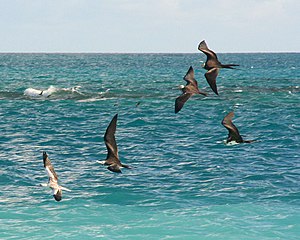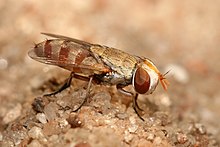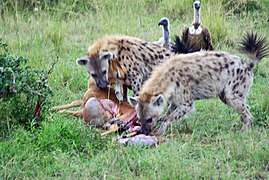Kleptoparasitism

Kleptoparasitism (originally spelt clepto-parasitism,
Strategy
Kleptoparasitism is a feeding strategy where one animal deliberately steals food from another. This may be intraspecific, involving stealing from members of the same species, or interspecific, from members of other species.[3][4] The term denotes a form of parasitism involving theft, from Greek κλέπτω (kléptō, 'steal').[5] The strategy has been widely studied in birds; in four families, all seabirds, the Fregatidae, Chionididae, Stercoraridae, and Laridae, it occurs in more than a quarter of the species.[6][4]
Such a strategy should only be followed if it is evolutionarily stable, meaning that it offers a selective advantage to individuals that practise it. Kleptoparasitism costs time and energy which could otherwise be spent directly on feeding, so this cost must be outweighed by the benefit in energy gained from the stolen food. Mathematical modelling suggests that when food is abundant, ordinary feeding is the best strategy; when food abundance falls below a critical level, kleptoparasitism suddenly becomes advantageous, and aggressive interactions become common. Similarly, when potential victims are rare or widely dispersed, the time needed to find them may not be justified by the food that might be stolen from them, resulting in frequency-dependent selection.[3][6]
Taxonomic distribution
Arthropods
Bees and wasps

There are many lineages of
| Host genus | Parasite genus |
|---|---|
Bombus |
Bombus (Psithyrus )
|
| Anthophora | Melecta, Zacosmia |
| Amegilla | Thyreus |
| Megachile | Coelioxys |
The
Others are dubbed kleptoparasitoids, namely parasitoids that select hosts that have been parasitized by another female. Kleptoparasitoids may make use of the punctures made by previous parasitoids on their hosts; may follow the trails or traces left by parasitoids to locate hosts; or use hosts already weakened by other parasitoids.[15]
Flies

Some
Dung beetles
Scarab dung beetles relocate large amounts of vertebrate dung, rolling balls of the material to their nests for their larvae to feed on. Several smaller species of dung beetle do not gather dung themselves but take it from the nests of larger species. For example, species of Onthophagus enter dung-balls while Scarabeus beetles are making them.[19]
True bugs

Many semiaquatic bugs (Heteroptera) are kleptoparasitic on their own species. In one study, whenever the bug Velia caprai (water cricket) took prey heavier than 7.9 g, other bugs of the same species joined it and successfully ate parts of the prey.[20]
Spiders

Kleptoparasitic spiders, which steal or feed on prey captured by other spiders, are known to occur in five families:
- Theridiidae (Argyrodes species)
- Dictynidae (Archaeodictyna ulova)
- )
- Symphytognathidae (Curimagua bayano)
- Mysmenidae (Isela okuncana, Kilifia inquilina, and Mysmenopsis species).[21]
Vertebrates
Birds
A few bird species are specialist kleptoparasites, while many others are opportunistic.
During
Gulls are both perpetrators and victims of opportunistic kleptoparasitism, particularly during the breeding season. While the victim is most often another member of the same species, other (principally smaller) gulls and terns can also be targeted. In the Americas, as brown pelicans surface and empty the water from their bills, they sometimes have their food stolen by Heermann's gulls and laughing gulls, which lurk nearby and grab escaping food items.[28] Great black-backed gulls are skilled kleptoparasites, stealing from other gulls and from raptors. Several species of gull steal food from humans, for example takeaway food at seaside resorts.[29]
-
Western gull in pursuit of an elegant tern
-
The flying cormorant has taken a fish from the one in the water.
Mammals
The relationship between spotted hyenas and lions, in which each species steals the other's kills,[30] is a form of kleptoparasitism.[20] Cheetahs are common targets. Bears, coyotes and wolves are very opportunistic and all have this behavior. Crab-eating macaques have also exhibited kleptoparasitic behaviors. All hyena species engage in this behavior when they can, as do jackals.[31] Human hunters may commonly take the remains of fresh kills from other carnivores, such as lions and Eurasian lynx.[32][33][34] Risso's dolphins have been observed charging "head-on" at sperm whales, causing them to open their mouths; it has been suggested that the observed harassment results in some regurgitation, and that the food is then eaten by the Risso's dolphins. The behaviour is rare and may be opportunistic.[35]
-
A little later, hyenas have driven off the cheetah and are feeding.
See also
References
- ^ Rothschild, M.; Clay, T. (1957). Fleas, Flukes and Cuckoos. A study of bird parasites. New York: Macmillan. p. 10.
- ISBN 978-0-19-860027-5.
- ^ S2CID 56407575.
- ^ ISBN 978-0521301787.
- ISBN 9780080453378.
- ^ S2CID 53151684.
- ^ ISBN 978-0-08-049015-1.
- S2CID 7124725.
- ^ Deslippe, Richard (2010). "Social Parasitism in Ants". Nature Education Knowledge. Retrieved 25 May 2022.
- ^ Emery, Carlo (1909). "Über den Ursprung der dulotischen, parasitischen und myrmekophilen Ameisen" [On the Origin of Dulotic, Parasitic, and Myrmecophilic Ants]. Biologisches Centralblatt (in German). 29: 352–362.
- JSTOR 25085241.
- PMID 15019524.
- .
- S2CID 853556.
- .
- ^ Wild, A.L. & Brake, I. 2009. Field observations on Milichia patrizii ant-mugging flies (Diptera: Milichiidae: Milichiinae) in KwaZulu-Natal, South Africa. African Invertebrates 50 (1): 205–212.[1] Archived 2009-05-15 at the Wayback Machine
- ^ Sivinski, J., S. Marshall and E. Petersson (1999) Kleptoparasitism and phoresy in the diptera. Florida Entomologist 82 (2) [2] Archived 2008-09-10 at the Wayback Machine
- ^ Marshall, S.A. & Pont, A.C. (2013). The kleptoparasitic habits of Musca albina Wiedemann, 1830 (Diptera: Muscidae). African Invertebrates 54(2): 427–430.[3]
- JSTOR 3999694.
- ^ JSTOR 3566063.
- ^ Coyl, F. A.; O'Shields, T. C.; Perlmutter, D. G. (1991). "Observations on the behaviour of the kleptoparasitic spider, Mysmenopsis furtiva (Araneae, Mysmenidae)" (PDF). Journal of Arachnology. 19: 62–66. Archived from the original (PDF) on 2006-05-13. Retrieved 2006-07-11.
- ^ ISBN 0-19-858407-5.
- .
- ^ Jorde, D.G.; Lingle, G (1998). "Kleptoparasitism by Bald Eagles wintering in South-Central Nebraska" (PDF). Journal of Field Ornithology. 59 (2): 183–188. Archived from the original (PDF) on 2007-08-10. Retrieved 2007-08-21.
- ISBN 0-7136-3861-3.
- ISBN 0-7136-6250-6.
- S2CID 84078011.
- ISBN 84-87334-20-2.
- ^ Sample, Ian (7 August 2019). "Stare seagulls out to save your snacks, researcher says". The Guardian. Retrieved 1 September 2022.
- ISBN 1-890132-44-6.
- ^ Estes, op. cit., 281–295, 339–346
- ^ Walker, Matt (24 July 2009). "People steal meat from wild lions". BBC Earth News. Retrieved 2009-08-01.
- .
- ^ Krofel, Miha; Kos, Ivan; Linnell, John; Odden, John; Teurlings, Ivonne (2008). "Human Kleptoparasitism on Eurasian Lynx (Lynx Lynx L.) in Slovenia and Norway" (PDF). Varstvo Narave. 21: 93–103. Archived from the original (PDF) on 2022-06-16. Retrieved 2022-05-25.
- S2CID 86227330.




